Middlesex
Explore hidden histories, historic photos, and things you never knew about Middlesex from the collections and archives of Historic England.
Discover your local listed buildings and places
Introducing some of Middlesex's most historic sites, included in the National Heritage List for England. Some of these captions have been summarised by AI. Click through for the official List entry. Skip this section and go to place by numbers
Bell Barrow called Boadicea's Grave, 650m west of Millfie…
Camden
Known in local folklore as 'Boadicea's Grave,' this scheduled monument is near the top of Parliament Hill, London.
Tomb of Mary Wollstonecraft, William Godwin and Mary Jane…
Camden
This tomb in St Pancras Old Church Garden, Camden, includes inscriptions for the writers and radical philosophers Mary Wollstonecraft and William Godwin.
The Light House, including hard landscaping and summer ho…
Camden
Post-Modern house with hard landscaping and summer house to the garden, designed in 1983 and built between 1984 and 1985 to designs by architect Ivan Simovic for his family.
Buckingham Palace
City of Westminster
Buckingham Palace has served as the official London residence of the UK's monarch since 1837.
Elsyng Palace
Enfield
A multi-phase complex monument with medieval origins, later converted to an early Tudor courtier house belonging to Sir Thomas Lovell which was then taken over and adapted as a royal palace...
No.1 Poultry
City and County of the City of London
Speculative commercial building incorporating offices and retail units, the Green Man public house, a public right of way in Bucklersbury Passage and rooftop restaurant and garden.
Lamp post outside 4-6 Russell Street
City of Westminster
A gas street light comprising a column dated 1910, with an Upright Rochester lantern manufactured by William Sugg and Company Limited, probably around 1930.
Heinz Administrative Headquarters and Former Research Lab…
Hillingdon
These two buildings were designed by Gordon Bunshaft of the American practice Skidmore, Owings and Merrill, and completed in 1965 as the administrative headquarters and research laboratories...
Houses of Parliament and The Palace of Westminster
City of Westminster
The official seat of the British Government, the Houses of Parliament and the Palace of Westminster, London, were created in two main phases, starting with Westminster Hall between 1097 and...
Tomb of Emmeline Pankhurst
Kensington and Chelsea
Tomb of Emmeline Pankhurst, 1930, designed by Julian Phelps Allan. Read the official list entry to find out more.
Liverpool Street Station
City and County of the City of London
London railway terminus built between 1873 and 1875 for the Great Eastern Railway by chief engineer Edward Wilson.
Virginia Quay Settlers Monument
Tower Hamlets
A free-standing stone and bronze monument of 1951, incorporating a bronze plaque of 1928 and with later sculptural additions of 1999, commemorating the departure of settlers for Jamestown,...
Cathedral Church of St Paul
City and County of the City of London
The new St Paul's Cathedral was rebuilt on the site of a medieval cathedral that burnt down during the Great Fire of London in 1666.
Gasholder No 2, Fulham Gasworks
Hammersmith and Fulham
Gasholder. Built in 1829-1830 to the design of John Kirkham of the Imperial Gas Light Company. The contractors were a Mr Ward, junior, and a Mr Wright.
Natural History Museum, Front Lodge and Gates, Gatepiers …
Kensington and Chelsea
Museum of 1873-81 and gates, piers and railings erected by 1881, all designed by Alfred Waterhouse and built by George Baker and Sons of Lambeth.
Isle of Dogs Pumping Station, including transformer house…
Tower Hamlets
Storm water pumping station, 1986-1988 by John Outram Associates for the London Docklands Development Corporation and Thames Water.
Ironmongers' Hall, excluding Ferroners' House
City and County of the City of London
Livery hall, 1923-1925 by Sydney Tatchell, with 1977-1979 additions by Fitzroy Robinson; the large 1975-1977 extension by Fitzroy Robinson, Ferroners' House, is excluded from the listing.
Shadwell Basin Housing, 5-54 (cons) Maynards Quay, 1-62 (…
Tower Hamlets
Flats, maisonettes and houses comprising the Newlands Quay, Maynards Quay and Peartree Lane developments.
Victoria Station Arcade including Nos. 15 and 16 Terminus…
City of Westminster
Shopping arcade incorporating entrances to Underground station, with attached range of shopsBuilt 1909-11 to the design of George C Sherrin, with minor modifications by HW Ford.
Stockley Park: Business park Phases I and II, and country…
Hillingdon
A pioneering suburban business park, established to a master plan of 1984 by Arup Associates, led by Michael Lowe, and mainly developed from 1985 to 1993, with landscape architects Ede...
Lamp post opposite Theatre Royal, outside 29 Russell Street
City of Westminster
A gas street light comprising a column dated 1910, with an upright Rochester lantern manufactured by William Sugg and Company Limited, probably around 1930.
Lilian Baylis House (former Decca recording studios), inc…
Camden
Former Crystalate and Decca recording studios, built as the Falcon Works in 1884.
Lloyd's Building
City and County of the City of London
A late C20 High Tech office building and insurance market for the major insurance firm, Lloyd's.
Tower of London
Tower Hamlets
The Tower of London evolved from a 13th-century tower keep to an enclosure castle, symbolizing Crown authority, serving as a landmark in military architecture and housing the first English...
10, Downing Street SW1
City of Westminster
Number 10, Downing Street, London, has been the official residence of the British Prime Minister, as First Lord of the Treasury, since 1735.
Former French Protestant Hospital (later Cardinal Pole Sc…
Hackney
Hospital and almshouse, later school; 1864-5 by Robert Lewis Roumieu. Read the official list entry to find out more.
Early C17 cistern to Old Somerset House (aka The Roman Bath)
City of Westminster
Cistern of early C17 date and later C17 vaults. Opened as a bathhouse in late C18. Read the official list entry to find out more.
Former Bromley Hall School for the Physically Handicapped
Tower Hamlets
School for physically disabled children, designed 1965 and built 1967-8 by the LCC/GLC Architects' Department under job architect Bob Giles; extended 1978-9.
The Barbican
City and County of the City of London
The Barbican, designed by Chamberlin Powell and Bon, is a notable mixed-use complex featuring residential, communal, and public gardens, developed on World War II bomb sites from 1962-1982.
ROYAL HOSPITAL, CHELSEA and RANELAGH GARDENS
Kensington and Chelsea
The Royal Hospital, Chelsea, developed in the 19th century, features historical gardens and plays host to the annual Chelsea Flower Show.
Grand Hall and Pillar Hall, Olympia Exhibition Centre
Hammersmith and Fulham
Olympia Exhibition Centre comprising: The Grand Hall, the former National Agricultural Hall, and Pillar Hall, the former Minor Hall, both of 1885 in Italianate style by Henry Edward Coe with...
Lamp post outside 24 Russell Street
City of Westminster
A gas street light comprising a column dated 1910 by William Sugg and Company Limited, with a replacement Upright Rochester-type lantern installed by Sugg Lighting Limited, in the later C20.
Baker Street Station: Main Entrance Building and Metropol…
City of Westminster
Underground railway station and terminus.
71-77, Lombard Street EC3, 15-22, Cornhill EC3
City and County of the City of London
Lloyd's Bank Headquarters on Lombard Street and Cornhill Street, built between 1927-30 by prominent architects, features imposing Beaux Arts and Moderne-styled interiors with historical...
Former Great Eastern Hotel
City and County of the City of London
A station hotel, built in 1883-1884 and designed by Charles Barry Junior and his son and partner Charles Edward Barry and extended in 1901 to the designs of Colonel RW Edis and Maples, with...
124-126 Horseferry Road
City of Westminster
London headquarters of Channel Four Television, including offices, post-production edit suites, restaurant, screening room and originally a studio.
Lamp post outside 34-43 Russell Street
City of Westminster
A gas street light comprising a column dated 1910, with an Upright Rochester lantern manufactured by William Sugg and Company Ltd, probably installed around 1930.
41 Albemarle Street, London W1
City of Westminster
Showroom and offices for Hille, 1961-3 by Peter Moro. Read the official list entry to find out more.
Explore more
Search for more listed placesMiddlesex through time
This timeline shows the first period of use for buildings and places on the National Heritage List for England, just one of the details recorded for every list entry. Click around to see how Middlesex changes over time. Skip this section and go to aerial photos
Prehistoric Before AD 43
Prehistory covers a million years of human occupation before the Roman invasion and the introduction of writing. Primarily hunter-gatherers of several human species including Neanderthals, the peoples moved across Europe, hunting animals, exchanging ideas and developing complex culture and belief systems including burial rites and astronomical understanding, as at Stonehenge for example.
Roman AD 43 to AD 410
Britain was invaded by four legions of the Roman army in AD 43, who relatively rapidly conquered England from landing points in Kent. Parts of Wales and Scotland soon followed.
Roman culture brought urbanism, monumental buildings, wide-ranging religious beliefs, writing, and strong social hierarchy. The Roman administrative system was withdrawn in AD 410.
Early medieval AD 410 to AD 1066
This period, often associated in England with Anglo-Saxons and Vikings, saw a reduction in urban living from the Roman period and increased migration from northern Europe.
Traces of this period can be found in cemeteries, particularly in artefacts and in some of the very early churches, as this period also saw the growth of Christianity in Britain.
Medieval AD 1066 to AD 1540
This period, sometimes known as the Middle Ages, began with the Norman invasion in AD 1066. It saw a significant rise in military and defensive buildings such as castles and earthworks, as well as religious houses dominating a largely agricultural landscape.
The monarchy and Church dominated the period, which also saw the break with the Roman Catholic Church and the English reformation.
Post medieval AD 1540 to AD 1901
The Post-Medieval period brought seismic changes to life in England, with religious reformation leading to the democratization of worship and the destruction of hundreds of religious houses.
In parallel, there was a huge expansion of scientific study and enlightenment that permanently altered the nation's social structure and landscape. Industrialization and mass production lead to wider global trade, emigration, and immigration.
20th century AD 1901 to AD 2000
The 20th century saw an incredible expansion of England's transport networks, with suburban growth shadowing rapid infrastructural expansion. The establishment of state schools, hospitals, and modern technical colleges, with new architectural styles, radically changed the appearance of towns and cities.
Two catastrophic world wars and the 1918 pandemic also brought unprecedented change, altering England's built environment and social structures forever.
Prehistoric Before AD 43
Prehistory covers a million years of human occupation before the Roman invasion and the introduction of writing. Primarily hunter-gatherers of several human species including Neanderthals, the peoples moved across Europe, hunting animals, exchanging ideas and developing complex culture and belief systems including burial rites and astronomical understanding, as at Stonehenge for example.
Roman AD 43 to AD 410
Britain was invaded by four legions of the Roman army in AD 43, who relatively rapidly conquered England from landing points in Kent. Parts of Wales and Scotland soon followed.
Roman culture brought urbanism, monumental buildings, wide-ranging religious beliefs, writing, and strong social hierarchy. The Roman administrative system was withdrawn in AD 410.
Early medieval AD 410 to AD 1066
This period, often associated in England with Anglo-Saxons and Vikings, saw a reduction in urban living from the Roman period and increased migration from northern Europe.
Traces of this period can be found in cemeteries, particularly in artefacts and in some of the very early churches, as this period also saw the growth of Christianity in Britain.
Medieval AD 1066 to AD 1540
This period, sometimes known as the Middle Ages, began with the Norman invasion in AD 1066. It saw a significant rise in military and defensive buildings such as castles and earthworks, as well as religious houses dominating a largely agricultural landscape.
The monarchy and Church dominated the period, which also saw the break with the Roman Catholic Church and the English reformation.
Post medieval AD 1540 to AD 1901
The Post-Medieval period brought seismic changes to life in England, with religious reformation leading to the democratization of worship and the destruction of hundreds of religious houses.
In parallel, there was a huge expansion of scientific study and enlightenment that permanently altered the nation's social structure and landscape. Industrialization and mass production lead to wider global trade, emigration, and immigration.
20th century AD 1901 to AD 2000
The 20th century saw an incredible expansion of England's transport networks, with suburban growth shadowing rapid infrastructural expansion. The establishment of state schools, hospitals, and modern technical colleges, with new architectural styles, radically changed the appearance of towns and cities.
Two catastrophic world wars and the 1918 pandemic also brought unprecedented change, altering England's built environment and social structures forever.
Aerial photos of Middlesex
Aerial photography helps reveal secrets of England's changing landscapes that are impossible to see from the ground. Skip this section and go to archive images
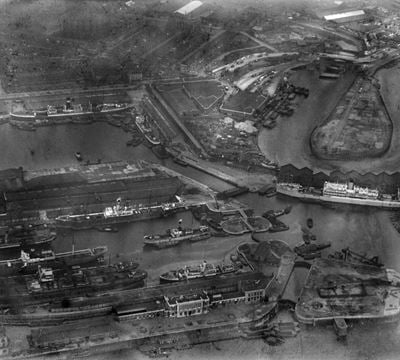
Blackwall
East India Docks, Blackwall, 1921

Blackwall
Brunswick Wharf (Blackwall) Power Station, East India Docks and environs, Blackwall, 1953
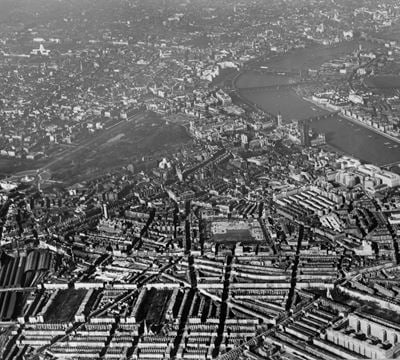
Westminster
Pimlico and Victoria Station looking towards St James Park and Waterloo Bridge, Westminster, 1939
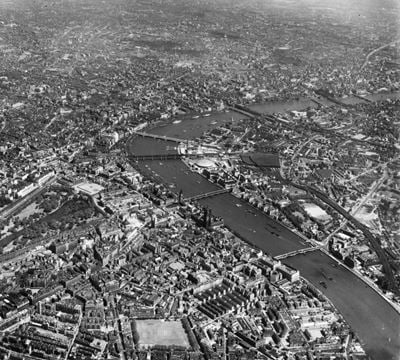
Westminster
The River Thames running through central London, Westminster, 1951
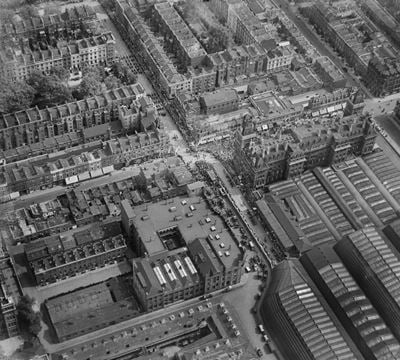
Paddington
Paddington, the homecoming parade of the Prince of Wales, 1922
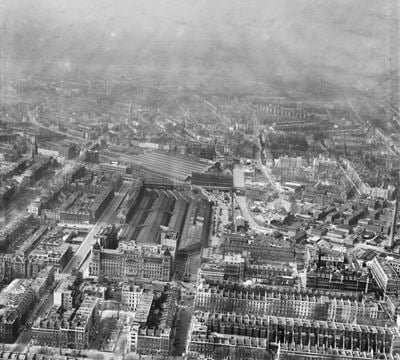
Paddington
Paddington Railway Station and environs, Paddington, 1950

London
London Zoo in Regent's Park, London, 1921
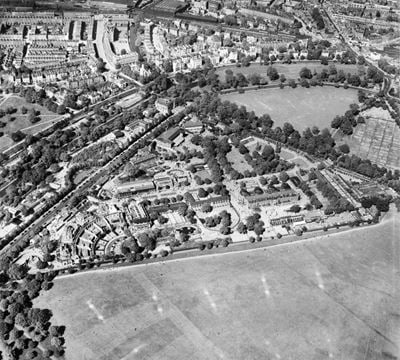
Regent'S Park
London Zoo, Regent's Park, 1950
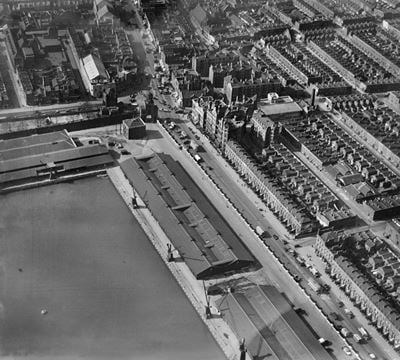
Poplar
Poplar Hospital, East India Dock Road and the North Quay of East India Import Dock, Poplar, 1935
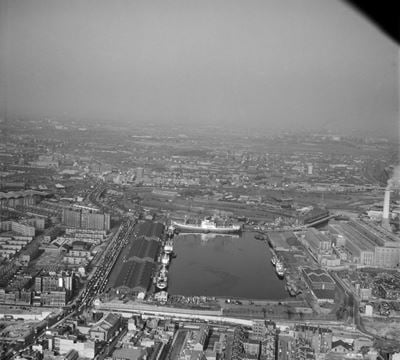
Isle Of Dogs
East India Dock, London, viewed, 1962
Middlesex in the Historic England Archive
The Historic England Archive cares for over 15 million images, dating from the 1850s to the present day. Discover stunning images of Middlesex's past. Skip this section and go to stories about heritage
Charles George Harper Collection
East Molesey, Richmond Upon Thames, Greater London Authority
Date created: 1892 - 1933
The Great Gatehouse at Hampton Court Palace, showing the ten heraldic statues, known as the King's Beasts, on the bridge over the moat
Eric de Mare
East Molesey, Richmond Upon Thames, Greater London Authority
Date created: 1945 - 1980
Exterior view of Hampton Court Palace showing a Roman statue on a wall.
John Gay Collection: Railway Stations
Marylebone, City Of Westminster, Greater London Authority
Date created: 1960 - 1972
A view looking west along Marylebone Road in Westminster from outside Berkeley Court towards the Old Great Central Hotel in Marylebone
John Gay Collection: London
East Molesey, Richmond Upon Thames, Greater London Authority
Date created: 1961
A young boy hanging on the railings edging the canal to the east of the gardens of Hampton Court Palace
John Gay Collection: Highgate and Hampstead
Highgate, Camden, Greater London Authority
Date created: Spring 1995
Graves in an overgrown part of the West Cemetery
John Gay Collection: Modern Architects
Walham Green, Hammersmith And Fulham, Greater London Authority
Date created: 1970 - 1975
The late 20th century local authority maisonettes at Walham Green Court in Fulham
John Gay Collection: Rural Life
City Of Westminster, Greater London Authority
Date created: Sep 1980
A view of a case containing two minature long barrelled guns made by James Purdey and Sons of London
John Gay Collection: Advertising and Promotional Photographs
Knightsbridge, Kensington And Chelsea, Greater London Authority
Date created: 1954 - 1972
A display of jars of Chiltern Herbs in Harrods Food Hall
John Gay Collection: Counties
Hillingdon, Greater London Authority
Date created: 1959 - 1963
The interior roof of an aircraft hangar at Heathrow Airport with the top half of a Bentley motor car in the foreground
John Laing Collection
Spelthorne, Surrey
Date created: 1925
View of the Littleton Pumping Station under construction
London, Midland and Scottish Railway Company
Richmond Upon Thames, Greater London Authority
Date created: Jul 1890
Two men standing on the bank of the River Thames, with the Richmond Railway Bridge behind
Nigel Temple Collection of Postcards of Parks and Gardens
Hampton Court, Richmond Upon Thames, Greater London Authority
Date created: 1900 - 1930
GENERAL VIEW OF THE MAZE
Stories about heritage in your local area
Historic England publishes news, blogs, research, videos, and podcasts celebrating England's rich heritage. Discover the stories we have about Middlesex. Skip this section and go to education
A Brief Introduction to Semi-Detached Housing
Mentions Numbers 2-16, 22-34, 36A and 36B and Attached Railings, Lloyd House and Attached Railings, Houses of Parliament and The Palace of Westminster
Semi-detached housing is the most prevalent type of housing in England today, making up one third of the housing stock.
How We Built Suburbia: The Development of England’s Suburbs
Mentions 3 and 5, Porchester Terrace W2
Over the past 2 centuries, England’s towns and cities have experienced unparalleled growth, which has led to the creation of the suburbs.
What Was the Capital of England Before London?
Mentions Tower Bridge (That Part in London Borough of Tower Hamlets), Westminster Abbey (The Collegiate Church of St Peter)
London is England’s capital city now, but when was it founded? And what was the capital of England before London?
Groundbreaking English Women of Science
Mentions The Learned Societies, Forecourt Buildings to Burlington House, Elizabeth Garrett Anderson Hospital
Discover the lives of women who impacted scientific discoveries in England's history, such as Marie Stopes and codebreaker Joan Clarke.
A History of Reading in 6 Places
Mentions Natural History Museum, Front Lodge and Gates, Gatepiers and Railings
Reading is the largest town in the UK. Discover the history of the town through its sites such as the Abbey Ruins, Reading Goal and Market Place.
10 Lesser Known Places Linked to King Henry VIII
Mentions Hampton Court Palace, Westminster Abbey (The Collegiate Church of St Peter), Ministry of Defence, Containing Sixteenth Century Undercroft and Historic Rooms Numbers 13, 24, 25, 27 and 79
Discover the lesser-known historic sites linked to Henry VIII, including Whitehall Palace, Windsor Castle, Rievaulx Abbey, and Eltham Palace, London.
6 Places Connected to Queer Jewish History in London
Mentions Hyde Park, Numbers 25-29 and Attached Railings and Lamp Holder
Discover the places connected to queer Jewish history in London including Hyde Park, Gateways Club in Chelsea, and the Colony Room Club.
What Is the Oldest Castle in England?
Mentions The White Tower
Discover the oldest English castle contenders, including the Norman Berkhamsted Castle, Windsor Castle, Dover Castle and The White Tower, London.
Photographing the First World War on the Home Front
Mentions Clement House, Victoria Embankment Gardens
Life changed on the home front in England during the First World War. This photography collection provides a glimpse into what it was like.
English High Street Architecture Through the Ages
Mentions 34, Haymarket SW1, Barclays Bank, 20 The Town, Enfield
Explore how the architecture of the English high street has evolved over the centuries.
The Life and Works of Visionary Engineer Isambard Kingdom Brunel
Mentions Thames Tunnel, Paddington Station Including the Lawn, Gwr Office Block on London Street and Offices Along Eastbourne Terrace, Statue of IK Brunel
Discover the bridges, structures and ships that Isambard Kingdom Brunel designed, including the Great Western Railway and Clifton Suspension Bridge.
12 Places Connected to Queen Elizabeth I
Mentions The Charterhouse, Hampton Court Palace
Discover the locations where Queen Elizabeth I lived and visited, including Hampton Court Palace, Hatfield House and Kenilworth Castle.
London’s Battle of Britain Bunker Still Revealing its Secrets
Mentions Group Operations Room
Recent archaeological work at the Battle of Britain Bunker in Uxbridge reveals more about the site, 86 years after it was built.
Southend-on-Sea Civic Fountain Listed
Mentions Curzon Mayfair Cinema, Harrods
The Civic Fountain in Southend-on-Sea, Essex, has been listed at Grade II by DCMS on the advice of Historic England.
Praise for Restoration of Former Sanderson Wallpaper Factory
Mentions Voysey House
Historic England has praised the restoration of Voysey House in Chiswick, as Sanderson returns to their former wallpaper factory building.
13th Cabmen's Shelter in London Listed
Mentions Cabmen's Shelter, Wellington Place, Chelsea Embankment Cabmen's Shelter, Cabmen's Shelter, Northumberland Avenue
The cabmen's shelter on Wellington Place, St John’s Wood, has been listed at Grade II – all 13 historic green huts in London are now protected.
Historic England Supports University of Sussex Plans for Listed Library
Mentions The British Library, piazza, boundary wall and railings to Ossulston Street, Euston Road and Midland Road
Historic England supports plans to improve access to the University of Sussex’s Grade II* listed Library, designed by architect Sir Basil Spence.
Listing Protection for Westminster Gas Lamps
Mentions Sewer Gas Lampstandard Numbered 4, Lamp post outside 4-6 Russell Street, Lamp post outside 24 Russell Street
4 historic gas lamps in Covent Garden, London have been listed at Grade II.
16 Remarkable Historic Places Listed in 2023
Mentions The Light House,
Take a closer look at the historic gems that were examined, protected and added to the National Heritage List for England in 2023.
Grant Awarded to Alexandra Palace to Help Restore Unique Spaces
Mentions Alexandra Palace
Historic England has awarded a £550,312 grant to Alexandra Palace to help bring a derelict section of the East Wing back into use.
Heritage at Risk in London Revealed
Mentions The London Hospital, Church of St George in the East
41 sites have been saved and 10 sites added to the Heritage at Risk Register 2023 in London.
34 Belsize Lane Listed
Mentions 34 Belsize Lane,, Middlesex
A unique 1970s studio house in Camden, London designed by British Architect Georgie Wolton has been listed at Grade II.
Bedford Shire Hall Upgraded To Grade II* Listing
Mentions Natural History Museum, Front Lodge and Gates, Gatepiers and Railings, Prudential Assurance Building
Bedford Shire Hall, which sits within the Bedford High Street Heritage Action Zone, has been upgraded to Grade II* by the Department for Culture,...
Harlow New Town Roman Catholic Church Upgraded to Grade II* Listing
Mentions Roman Catholic Church of St Gregory the Great and church hall, Roman Catholic Church of St Thomas More
The Roman Catholic Church of Our Lady of Fatima in Harlow has been upgraded to Grade II* by DCMS on the advice of Historic England.
Middlesex's social history through photos
Over 10,000 images from the Historic England Archive have been specially selected and re-captioned for teachers, students, and anyone who wants to learn more about their local area. Skip this section and go to grant-aided places
Zoological Gardens, Regents Park, Westminster, London
Period: Victorian (1837 - 1901)
This stereo view of the Zoological Gardens in Regents Park shows members of the public mounting an elephant for a ride.
Zoological Gardens, Regents Park, Westminster, London
Wrotham Park, Dancers Hill Road, Potters Bar, Hertfordshire
Period: Victorian (1837 - 1901)
This is the entrance to Wrotham Park. The landscaped park and pleasure grounds to Wrotham Park House cover an area of 116 hectares.
Wrotham Park, Dancers Hill Road, Potters Bar, Hertfordshire
Wright's Almshouses, Hertford Road, Enfield, Greater London
Period: Victorian (1837 - 1901)
This row of almshouses were built in 1847.
Wright's Almshouses, Hertford Road, Enfield, Greater London
Wrapping port bottles, Cutler Street Warehouse, City of London
Period: 1950s (1950 - 1959)
An interior view inside the warehouse showing a man individually wrapping bottles of Sandeman port.
Wrapping port bottles, Cutler Street Warehouse, City of London
World War II bomb damage, London
Period: 1940s (1946 - 1949)
A panoramic view of bomb damage in Cripplegate during World War II. A site has been cleared in the foreground and is being used as a car park.
World War II bomb damage, London
Tags
World War II bomb damage, London
Period: 1940s (1946 - 1949)
A panoramic view of extensive bomb damage at Cripplegate in London during World War II. The Church of St Giles lies to the right of the photograph.
World War II bomb damage, London
Tags
Workmen in a canteen during construction at Heathrow Airport, Heathrow, Greater London
Period: 1970s (1970 - 1979)
These workmen are from John Laing plc and were building a new hangar at Heathrow Airport. The men are having a meal and a break in the site canteen.
Workmen in a canteen during construction at Heathrow Airport, Heathrow, Greater London
Workmen dismantling a tower crane while building the Barbican, City of London, Greater London Authority
Period: 1960s (1960 - 1969)
The Barbican Estate was built by John Laing plc between 1965 and 1976.
Workmen dismantling a tower crane while building the Barbican, City of London, Greater London Authority
Visit grant-aided places near you
These places and buildings have been helped by Historic England's financial grants. Find historic places in your neighbourhood that you never knew existed! Please note that opening times may vary. Skip this section and go to related locations
East and West Stables, Gunnersbury Park
These listed structures within a Grade II* registered park and garden have undergone necessary safety, stabilization, and weatherproofing repairs.
St Stephen, Pond Street
Grade I listed landmark building at the intersection of Rosslyn Hill and Pond Street, constructed in 1869-71 in early French Gothic style.
Monument to Major John Cartwright, St Mary-at-Finchley Churchyard
An obelisk set within a churchyard, situated above a burial vault.
St Pancras Old Church, Camden
Old Church
Parish Hall and Church of Our Most Holy Redeemer, Exmouth Market
The Parish Hall (Institute) and the adjoining Church are integral parts of a Grade II* range of buildings.
Discover more
Ready for more local heritage? Take a look at these other places nearby

Brent
Local Authority District

Ealing
Local Authority District

Hammersmith and Fulham
Local Authority District